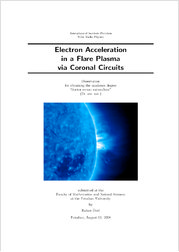| dc.contributor.author | Önel, Hakan | |
| dc.date.accessioned | 2010-10-12T18:22:51Z | |
| dc.date.available | 2010-10-12T18:22:51Z | |
| dc.date.issued | 2008 | |
| dc.identifier.uri | http://hdl.handle.net/11858/00-1735-0000-0001-30A6-0 | |
| dc.description.abstract | The Sun is a star, which due to its proximity has a tremendous influence on Earth. Since its very first days mankind tried to "understand the Sun", and especially in the 20th century science has uncovered many of the Sun's secrets by using high resolution observations and describing the Sun by means of models. As an active star the Sun's activity, as expressed in its magnetic cycle, is closely related to the sunspot numbers. Flares play a special role, because they release large energies on very short time scales. They are correlated with enhanced electromagnetic emissions all over the spectrum. Furthermore, flares are sources of energetic particles. Hard X-ray observations (e.g., by NASA's RHESSI spacecraft) reveal that a large fraction of the energy released during a flare is transferred into the kinetic energy of electrons. However the mechanism that accelerates a large number of electrons to high energies (beyond 20 keV) within fractions of a second is not understood yet. | |
| dc.format.extent | 122 S. | |
| dc.format.mimetype | application/pdf | |
| dc.language.iso | eng | |
| dc.publisher | Univ. Potsdam | |
| dc.rights.uri | http://e-docs.geo-leo.de/rights | |
| dc.subject.ddc | 523 | |
| dc.subject.gok | TGC 560 | |
| dc.subject.gok | TGC 440 | |
| dc.title | Electron acceleration in a flare plasma via coronal circuits | |
| dc.type | monograph | |
| dc.subject.gokverbal | Eruptionen, Flares {Astronomie: Sonne} | |
| dc.subject.gokverbal | Korpuskelstrahlung {Sonne} | |
| dc.identifier.doi | 10.23689/fidgeo-36 | |
| dc.identifier.ppn | 600980464 | |
| dc.identifier.urn | urn:nbn:de:kobv:517-opus-29035 | |
| dc.type.version | publishedVersion | |
| dc.relation.collection | Astronomie, Astrophysik, Weltraumforschung | |
| dc.description.type | thesis | |


